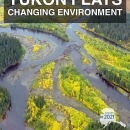Yukon Flats Refuge is the nation’s third largest wildlife refuge. With the Brooks Range to the north and the jagged limestone peaks of the White Mountains to the south, this refuge encompasses the so-called "Yukon Flats" - a vast fire-dependent area of wetlands, forest, bog, and low-lying ground centered on the confluence of the Yukon, Porcupine, and T'eedriinjik (Chandalar) rivers. The Flats are a critical waterfowl breeding ground due to the large area of wetland provided by the estimated 40,000 small lakes and streams in the area. The refuge also encompasses the section of the Yukon River that serves as a key breeding ground for Alaska's only endemic fish, the Bering Cisco. For thousands of years, this area has been—and continues as—a homeland for Gwich’in and Koyukon Athabascan people.
Yukon Flats National Wildlife Refuge
Alaska’s largest boreal wetland basin

